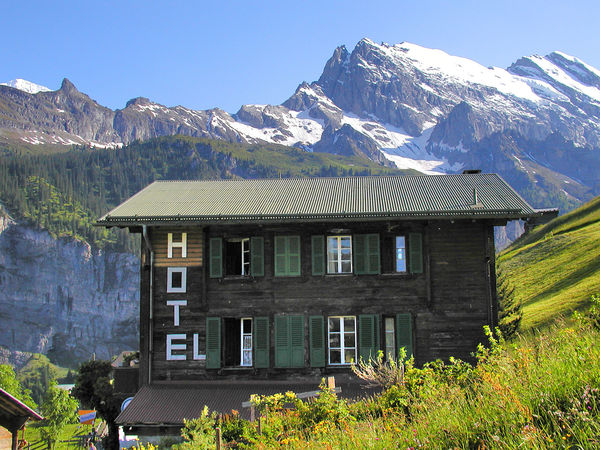Gimmelwald: The Swiss Alps in Your Lap
The rustic village of Gimmelwald, hanging on a cliff high above Switzerland's Lauterbrunnen Valley, is just this side of heaven.
By Rick Steves
When told you're visiting Gimmelwald, Swiss people assume you mean the famous resort in the next valley, Grindelwald. When assured that Gimmelwald is your target, they lean forward, widen their eyes, and — with their sing-songy Swiss-German accent — ask, "Und how do you know about Gimmelvald?"
Clever travelers know to seek out the offbeat places, skipping the resorts and focusing instead on gems like Gimmelwald. This traffic-free village hangs nonchalantly on the edge of a cliff, high above the Lauterbrunnen Valley, 30 minutes south of Interlaken by car or train.
This sleepy village has more cow troughs than mailboxes. Here, white-bearded, elfish old men smoke hand-carved pipes while overseeing the occasional farmer chugging by on a mini-truck towing a wobbly wagonload of hay. Stones called Schindles sit like heavy checkers on old rooftops, awaiting nature's next move. While these stones protect the slate from violent winter winds, in summer it's so quiet you can hear the cows ripping tufts of grass. Only a vast sea of mountain air separates Gimmelwald from cliff faces that rise up from the other side of the valley. Small avalanches across the valley look and sound like distant, momentary waterfalls. Kick a soccer ball wrong and it ends up on the valley floor, a quarter-mile below you.
Each year, the people of Gimmelwald systematically harvest the steep hillside outside their windows. Entire families cut and gather every inch of hay. After harvesting what the scythe can reach, they pull hay from nooks and crannies by hand. Half a day is spent on steep rocks harvesting what a machine can cut in two minutes on a flat field. But it's tradition. It's like breathing. And there's only one right way to do it.
To inhale the Alps and really hold it in, sleep high in Gimmelwald. Poor but pleasantly stuck in the past, the village has two guesthouses, a decent pension, happy hostel, and a couple of chalets rented on a weekly basis. My long-term home away from home, Hotel Mittaghorn — now set to reopen in 2025 after the death of its long-term proprietor, my good friend Walter Mittler — is a black-stained chalet with eight balconies, huge views, and a few tables shaded by umbrellas on its tiny terrace. Evening fun in Gimmelwald happens in the hostel, where young, Alp-aholic hikers are eager to share information on the surrounding mountains.
From the center of Gimmelwald, the cable car takes you either down to the valley floor (where connecting buses await), or up to the Schilthorn, a nearly 10,000-foot peak capped by the revolving Piz Gloria restaurant. The ride to the top goes twice hourly, involves two transfers, and takes 30 minutes. Watch as the altitude meter goes up, up, up. On a clear morning, get up early, hop one of the first connections to the summit, and eat breakfast with a thrilling 360-degree view. Sip your coffee slowly to enjoy one complete spin of the restaurant, watching paragliders methodically set up before jumping into airborne ecstasy.
The cable-car station below the Schilthorn summit, called "Birg," is a great starting point for high-country hikes. Even at the height of summer, within minutes of the Birg station you can easily find yourself completely alone, surrounded by a harsh and unforgiving alpine world. Anything alive is here only by the grace of nature. Once the whir of the cable car fades behind you, the tinkle of cowbells and the crunch of gravel dominate the soundscape, interrupted here and there by rushing streams. It's a steep, nearly five-hour descent to the Sprutz waterfall, then a wooded trail that deposits you in a meadow of flowers at the top end of Gimmelwald. (The mountainside also offers plenty of less demanding, equally scenic walks.)
A bench that sits at the high end of Gimmelwald is one of my "savor Europe" depots. A great dimension of travel is finding the right spot and just sitting still. From this bench, crickets rattle congratulatory castanets at weary hikers, a river blurts out of a glacier, and Mürren crowns the bluff above, keeping all the fancy tourists where they belong. An alpine farm sits high above the tree line, forever alone amid distant flecks of brown-and-white cows and goats. From the village center, the sound of children at play finds its way up the hillside.
Enjoying this alone is fine. But share this bench with a new friend, the sun of a daylong hike stored in your smiling faces, and you'll agree with what I've long said: "If Heaven isn't what it's cracked up to be, send me back to Gimmelwald."

